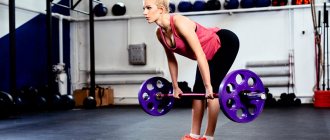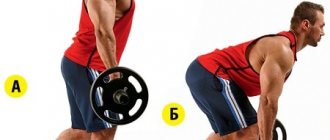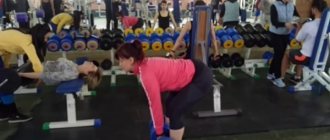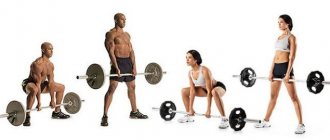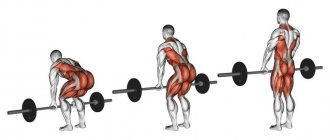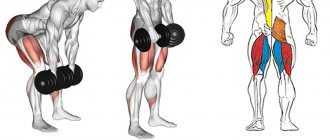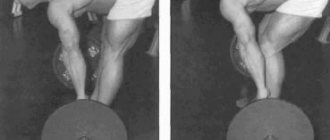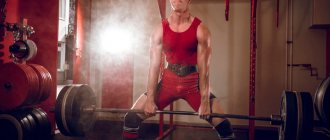Many representatives of the fair half of humanity dream of a fit, slender figure. You can achieve the desired result if you use the Romanian deadlift and follow the correct diet and do not skip workouts. The set of exercises is individual in each case, but often it contains exercises for each muscle group. Girls involved in sports and professional athletes often do such an exercise as the deadlift, but there is the so-called Romanian deadlift, which is slightly different in load and technique.
The main difference between the Romanian technique and the standard one is based on the fact that in the first case the bar must be lowered to the middle of the shin, not to the floor. This allows you to significantly reduce tension on the muscular system of the lumbar region and increase the number of repetitions
The name arose thanks to weightlifters from Romania, who were the first to take leading positions by doing this exercise on straight legs.
What is Romanian deadlift
This physical exercise is popular among both men and women. Romanian deadlift is a downward bend with an apparatus in your hands - a barbell or dumbbells - completely on straight legs or with bent knees. At the same time, a natural deflection must remain in the lower back, otherwise the risk of injury significantly increases. The back muscles are also protected due to the fact that the arms are lowered only to the middle of the shins. Unlike the classical technique, where the back is also worked out, the dead one helps to pump each thigh (its biceps) and buttocks, it does not put additional strain on the spine.
When can you do the exercise?
Unlike the classic deadlift, the deadlift (on straight legs) is ideal for girls and beginner athletes. It can be included in the training program as soon as the practitioner can stretch the muscles of the lower back and the back of the legs to the desired degree.
While there is no stretching, you cannot do the exercise.
Otherwise, you will round your lower back, which should not be allowed. And you won’t be able to lower the weight to the desired height. Stretching in most exercises is the basis of proper technique. If you have back pain, stiff-legged deadlifts may be painful. When this happens, train your back, abs, and leg flexors separately in machines. Once you have strengthened them sufficiently, you can move on to free weights. Then on to the classics.
Technique for performing the Romanian deadlift
The concept of “dead” is applied to such an exercise for a reason. It's all about translation from English. "Dead" sounds like "dead". The exercise itself is called “dead-lift”. This is a dead option. The most difficult type is on one leg. In addition to it, the press also begins to work, which acts as a stabilizer. The technique here is little different. The only difference is that when lowering, the non-working leg is pulled back.
The optimal way is to deadlift the barbell with straight legs. This makes it more convenient to control movement and keep the limbs at the same distance. Another option is stiff-legged deadlifts with dumbbells:
- It is less popular, because muscle tension here is not symmetrical.
- It is important to exclude even minimal deviations of projectiles. Only in this way will the technique of performing the Romanian deadlift be correct and ensure an even load on each part of the body.
Deadlift on straight legs from Romanian
The Romanian lumbar lift has a number of differences from the type of deadlift we are discussing:
- Knees bent. And the lower you bend, the greater this angle. You compensate for the pelvis moving backward by bending your knees. This does not mean that you should bend your knees too much, no. The angle is small - up to 10-15 degrees. This is enough to complete the exercise.
- We begin to move by moving the pelvis back. In the deadlift we tilt the body, but here it’s from the pelvis. He walked backwards, initiating lumbar flexion.
- We lower the barbell just below the knee, because it will be difficult to keep your back straight. In general, we go as low as our back allows. The Romanian deadlift is less dependent on your stretch because you bend your knees.
- The Romanian get-up puts a lot of stress on the glutes because when you return to the starting point, you have to squeeze them and push your pelvis forward. This is a good visual difference between the two exercises.
The Romanian barbell deadlift, like the stiff-legged deadlift, is more suitable for girls.
Romanian version - knees slightly bent to maintain a straight back position.
Romanian barbell deadlift
The traditional option is the Romanian barbell deadlift. This technique is optimal for girls. During execution, the back surface of the thighs and buttocks are loaded, which are difficult to correct in the fair sex. As a result, this area acquires a firm and attractive appearance. You need to do the exercise like this:
- Take the starting position - place your feet shoulder-width apart, bend your knees slightly, bend your lower back, and bend over.
- Take the barbell with an overhand grip. Place your hands so that they are slightly higher than shoulder width, keeping them straight or slightly bent at the elbows.
- As you exhale, lift up with the apparatus, leaving your lower back arched, and placing the barbell as close to your legs as possible so that it even touches your hips and shins.
- Inhale, straighten the body, and as you exhale, bend over again, smoothly and evenly lowering the projectile to approximately the middle of the shin.
Romanian deadlift with dumbbells
The Romanian deadlift with dumbbells is a little more difficult to perform. It should not be made basic. It is better if this exercise is sometimes replaced with a barbell option to diversify the load. Dumbbells are convenient because they slide along the body without creating discomfort when passing near the shins. The technique is as follows:
- Take the starting position - spread your legs shoulder-width apart, feet should be parallel, take a dumbbell in your hands, slightly bend your back at the lower back.
- Straighten your shoulders, bring your shoulder blades together. Keeping your back straight, lean forward, practically sliding the dumbbells, but only slightly to the side, and not from the front.
- Continue lowering until the middle of your shins and the body is parallel to the floor, only slightly bending your knees.
- Below, feel the tension of the muscles, then push off with your heels using the strength of your legs and, straightening your knees, move your pelvis forward until you assume the starting position.
Romanian single leg deadlift
The most difficult option is the Romanian single leg deadlift. It should be performed less often, just to improve performance and develop “lagging” muscles. For the first time, especially for beginners, it is recommended not to use weights in order to get a feel for the technique:
- Dumbbells - you can take them in both hands or just one, and in the one opposite the working leg.
- Take the starting position - bend your right knee and take your left leg back.
- Lean forward until your body becomes parallel to the floor. At the same time, straighten your left leg in line with the body. In another version, the non-working leg is simply moved back, but it turns out that it is also loaded a little less.
I have been working in the fitness industry for over 11 years, with 5 years in Australia. That is, in essence, I can conduct training in two languages. At the same time, I am always amazed at how easily I can explain the exercise to my Australian client and how many times Russian clients ask me again.
Most often, the dialogue in English looks like this:
Now you are going to perform pronated lateral raises with dumbells. Keep your arms slightly bent, lift your elbows to your shoulder level and try not to swing.
Ok.
In Russian the dialogue looks like this:
Now we will perform dumbbell abductions to the sides with pronation, that is, when lifting, you need to point your thumb down. Slightly bend your arms at the elbow joint, try not to swing the dumbbells, the highest point of lifting is the level of the shoulder joint.
Are these jugs or what?
This exercise is called dumbbell abduction to the side with pronation.
Well, yes, the coach called them jugs.
Personally, you can come up with any convenient association for yourself, but it’s worth remembering exactly the correct version of the name so that any trainer and student can speak the same language. At the same time, it is not at all necessary to understand the names of muscles, complex terminology characteristic only of scientific literature, or any specific terms. It is enough to simply call white white.
I once reposted a video from Sonya Nex with her “deadlift” exercise and wrote that it was NOT a deadlift, but a Romanian one. And indeed, then people get confused and do not understand how to correctly perform this or that exercise. Let's speak the same language and understand the differences between the Romanian, deadlift and deadlift.
DEADLIFT
DEADLIFT IS A COMPLEX COORDINATION EXERCISE AND BEGINNERS SHOULD NOT DO IT!
Personally, I include it only in the 3-4th cycle for beginners and in the second cycle for more prepared practitioners. Typically, before deadlifting, you need to master the squat and Romanian deadlift, as well as strengthen the muscles of the buttocks, legs and back. Doing deadlifts without proper preparation is suicide.
See how many muscles work in the exercise.
From the point of view of the sequence of inclusion of muscle groups in work, the following phases can be distinguished: 1) Beginning of traction - the gluteal muscle is actively involved in the work; 2) Knee extension and torso straightening - quadriceps and hamstrings are involved. 3) Holding the weight, bending - the load again falls on the muscles of the back of the thigh.
If we simplify any athlete to a stick man, then when performing a deadlift, his body with its “levers” (lower leg, thigh, torso, arms) forms a closed kinematic chain. In weightlifting, this type of model is called a rigid body with an “inertial link.” In general, it looks like this (see image).
The use of this model allows us to better understand the basic patterns of movement of parts of the human body when lifting a barbell. Having this simplified version before your eyes, you will easily understand the biomechanics and “phase composition” of traction. In essence, it is a squat and back extension, connected into a single monolithic block.
There are different versions of the deadlift: bodybuilding, powerlifting and weightlifting. There are various options for grips and foot placements. However, the movement itself is always the same.
The deadlift is often confused with the Romanian deadlift.
Look again at the biomechanics of movement. The Romanian deadlift will never allow you to lift as much weight as a deadlift. For example, I can do a 90kg deadlift for 10 reps, but only a 55kg Romanian deadlift for 10 reps.
By the way, I often see girls in the gym who constantly hold the barbell suspended. In the classic version, the weight must be lowered to the ground each time (attention! do not knock the weight off the floor!).
So, the main points of the deadlift:
- The deadlift can be an exercise to work the back muscles, or it can be an exercise to work the leg muscles. It all depends on how you distribute the accents. Ideally, both legs and back should work.
- The bar should be almost at your feet. When you pull the barbell up, it moves almost touching your hips.
- Don't look down, as you will involuntarily round your back. Be sure to lift your chin and push your chest forward. Look forward at the floor at a distance of 2 meters or in the mirror at your own knees
- There should be a slight arch in the lower back. If, when lifting a barbell from the floor, your back rounds, and this is due to insufficiently developed flexibility (especially the muscles of the back, buttocks and hamstrings), then do the exercise from a higher position. That is, place the stoppers in the squat rack at approximately mid-calf level and lift the barbell from there.
- Make sure your knees don't go inward. Imagine that you need to keep your little toes on the floor.
ROMANIAN DEADLIFT
The Romanian deadlift is often confused with the deadlift. I want to tell you what the difference is.
So, the main differences:
- With the Romanian deadlift, the knees are always slightly bent. When deadlifting with straight legs, the legs are (impossibly!) straight.
- In the Romanian deadlift, the movement begins with “pushing” the pelvis back. The bar then slides over your thigh. In straight-legged deadlifts, the pelvis is fixed, and the movement begins precisely by lowering the barbell vertically down.
- In the Romanian deadlift, the lowest point is the point at which you can keep your shoulder blades retracted and your back straight. Usually this is approximately just below the knee (maximum mid-calf). The stiff legged deadlift is all about your flexibility. If the back of the thighs are well stretched, then the stay can be lowered all the way to the toes, or even stand on a bench and lowered even lower.
- When returning to the starting position in the Romanian deadlift, it is important to push your pelvis forward and squeeze your buttocks. There is no forward movement of the pelvis in the straight leg deadlift. The pelvis remains motionless.
So here is a visual video for the ROMANIAN DEADLIFT. Most importantly, WATCH HOW TO DO IT.
DEAD LIFT, or STRAIGHT LEG LIFT
The picture clearly shows that the legs remain straight at all times.
Here's a prettier picture, but with the wrong caption. As you can see, in the English language there are also coaches who use terminology incorrectly.
So, the main points of traction on straight legs:
- When moving down, the legs remain straight. STRAIGHT! There is no need to squat slightly, although the knees can remain “soft,” that is, slightly bent in one position, throughout the exercise.
- When moving down, the bar moves straight down towards the middle of the foot.
- The back should remain straight throughout the entire exercise.
- The range of movement depends on flexibility. If you lack flexibility and your hamstrings don't allow you to bend deeply, the bar will drop just below your knee. If, on the contrary, you can stand on the podium/bench to bend deeper.
For those who speak English, I suggest LISTEN, and for those who don't, WATCH this video about the differences between the Romanian deadlift and the stiff legged deadlift.
I wish everyone safe training.
All questions about creating workouts and nutrition plans can be sent to me by email.
The Romanian deadlift is a representative of the most effective basic techniques, focused on, due to which this exercise is popular among both men and women.
The Romanian deadlift additionally works the calf, gluteal, lumbar and other types of muscles. Its main difference from the classic version of the deadlift is a significant reduction in the load on the lower spinal region, thereby minimizing the risk of muscle injuries and pain after physical activity.
Deadlift and deadlift. Features of the technology
Many bodybuilders are interested in the question: “What is the difference between a deadlift and a deadlift?” In fact, this is a rather subtle question. The exercises themselves are very similar in structure, the differences are only in seemingly insignificant details.
Key differences:
- Deadlifts are performed exclusively with straight legs. Constantly. As you move down, the legs remain straight, although the knees may be soft. There is no need to squat. Thanks to this, the load goes mostly to the buttocks and biceps of the thigh, rather than to the back and lower back. This makes the exercise very beneficial not only for the fair half of the world, but also for people who have problems with the strength of the lumbar muscles and it is advisable to transfer the load to nearby muscle groups.
- When performing an incline, the barbell or bar moves directly to the middle of the foot, not the middle of the shin.
- The back remains straight all the time.
- The amplitude of the exercise performed may vary depending on individual characteristics. This is quite acceptable, which means that if there is a lack of flexibility, when the back of the thigh does not allow you to bend low, you can lower the barbell only to the knee. If you have the opposite problem, you can stand on a bench to increase the inclination. Various implementation options can be seen in these photos.
Thus, the difference between deadlift and deadlift lies in the main load on different muscle groups, different inclination and support points.
Current advice
Wear shoes with no heels. The sole should be dense and wide, perfectly following the contours of the foot. It is advisable to wear such shoes only for training so that they do not wear out. This will ensure proper stability. It is recommended to lower the bar so that it is closer to the legs, lightly touching the thighs and shins. In this case, it reduces the load on the lumbar region and increases it on the legs. The head is on the same axis with the entire spinal column. The back should not be rounded. If this cannot be accomplished, you should place discs under your feet and perform the exercise from a higher position. You can also tilt as long as you can keep your back straight, without reaching the final point. If you cannot perform this exercise without rounding your back at all, it is better to stop the exercise so as not to injure the spine. If after a certain number of repetitions your back starts to hurt or get very tired, you need to include hyperextension in your training. This will further stimulate endurance and strength of the back muscles. It is necessary to perform the exercise using the whole body in a comprehensive manner. Do not rely on your arms or lower back when making a dangerous jerk
The exercise must be performed slowly and accurately. It is important to feel which muscles are working. If the load is felt in the wrong parts, you should change something in the deadlift.
It's also important to remember that recording your training results is a great way to continually track your progress. You can create a special notebook or notepad specifically for reporting on the number of approaches, repetitions and working weights
Taking photos periodically will also help you track your success.
In fact, the deadlift is an excellent exercise not only for developing muscles, but also tendons. Doing this exercise regularly will help increase the flexibility of your hamstrings. They will be able to withstand much more weight, therefore, the risk of all kinds of injuries is reduced to a minimum. Even if you give up training, the resulting flexibility will have a beneficial effect on your future life. The risk of musculoskeletal diseases is greatly reduced.
In conclusion, it is recommended to watch a video that clearly illustrates the correct execution of this exercise.
What is the Romanian deadlift and what muscles work?
Romanian (Bulgarian) deadlift is a technique that is performed on fully straightened legs (an option is when the legs are slightly bent at the knees), where the sports equipment is lowered only to the middle of the shin, which protects the muscles of the back and lumbar region from overstrain and allows you to perform a greater number of repetitions. In addition, when performing this exercise, the risk of injury is reduced.
This technique owes its name to weightlifters from Romania, who in the old days took the main prizes at the largest tournaments in the world. The Romanian is also called the straight-legged deadlift or the Romanian get-up.
If the classic version works with all the leg and back muscles, then the “Bulgarian” is more aimed at working the buttocks and biceps of the thighs (in particular its posterior surface), so this exercise is thoroughly used for the development of these particular muscle groups.
Correct technique for performing Romanian deadlifts
This technique can be performed with both a barbell and dumbbells. The first option is a higher priority, since with a barbell it is more convenient to control the movements of the barbell and keep the upper limbs at the proper distance from each other.
- It is best to perform the exercises not just in sneakers, but in shoes that securely fix the foot and eliminate the possibility of moving the fingers of the lower extremities.
- When performing this technique, you cannot hold the barbell with a different grip. This technique has a negative effect on the back. When performing the Romanian deadlift, it is important to use a wide, straight grip. In this case, it is advisable to use special bandages for the hands.
- “Bulgarian” deadlift and a rounded lower back are two incompatible concepts. The back should be flat, with a deflection in the lumbar region.
- Do not lift excessively heavy weights as there is a risk of back injury.
- For an “iron” position (balance), look straight ahead. For those who perform this exercise for the first time, it is best to do it in front of a mirror, so the athlete will be able to eliminate his mistakes and control the correct execution of the deadlift.
- Do not extend completely at the upper limit. This way, the back will not be overloaded and the buttocks will be tense throughout the entire execution.
- Before you start using the technique, you need to prepare a place to work. Place the apparatus on the floor so that nothing interferes with you while performing the technique.
Classic row with a barbell on straight legs
This technique is good for girls. When performing, the back of the thighs and gluteal muscles are primarily loaded. When done correctly, these places (which are difficult to correct for the fair sex) take on an attractive shape. These muscle groups in girls are poorly developed, the main reason being a sedentary lifestyle.
- Stand in IP: place your feet shoulder-width apart, bend your knees slightly. Inhale, bend in the lumbar region and bend over. Legs should be straight.
- Take the barbell with a straight grip. Hands should be separated from each other at a distance slightly greater than shoulder width. As you exhale, lift the sports equipment. In this case, the arms should be straightened, the deflection in the lumbar region should be maintained, and the barbell should be located as close to the legs as possible.
- Inhale and straighten your body, as you exhale, tilt and lower the projectile to the middle of your shin. The projectile must be moved smoothly and evenly.
- Repeat the exercise as many times as necessary.
- When lowering the bar, you need to keep it as close to your legs as possible, so that it touches your thigh and lower leg.
- This technique allows you to increase the load on the leg muscles and reduce the load on the lower back.
- The head must be kept in one vertical straight axis with the spine.
- Throughout the entire training, the back should remain straight; if this condition cannot be met, stop performing the deadlift.
- If you find it difficult to keep your back straight even with a small repetition, then include in your training complex exercises aimed at developing the back muscles.
- Do not lift the apparatus relying only on the strength of the upper limbs or lumbar region. This is a complex technique, and therefore requires competent work of the entire skeleton.
How to do it correctly with dumbbells
Romanian with such sports equipment as dumbbells is not so popular, the difference is that the load on muscle groups here is less symmetrical, and the technique is more complex. Throughout the entire execution, you need to strictly monitor and control the position of the dumbbells both vertically and horizontally, excluding even minimal deviations. This is the only way to ensure an even load on both sides of the body.
Single leg deadlift: video
The single leg exercise is a more difficult option. When performing, the gluteal muscles of the working leg are well worked out, as well as the abs, which perform a stabilizing role. The technique is similar, but along with lowering the body down, one leg is simultaneously pulled back. To understand how to perform this exercise correctly and what options exist for its execution, we suggest watching the following training video.
Doing the exercise in Smith: video
The Smith machine allows you to control the movement of the projectile and is perfect for girls and men who are getting acquainted with Romanian technology for the first time. The execution algorithm is similar to that described earlier, the main thing is not to forget to constantly ensure that your back is arched and tense. To visually familiarize yourself with the technique, we suggest watching an educational video from a professional athlete.
execution technique, difference from Romanian and classical
Deadlifts are included in all lists of exercises for strength training with weights, but not everyone can master it right away. Just a few nuances that an athlete forgets about can negate all the results of a hard workout. This material contains all the most important things about deadlifts on straight legs.
General concepts
One of the main basic competitive exercises in powerlifting is the deadlift or Dead Lift, which allows you to gain muscle mass in the lower back, hamstrings, and buttocks. It also uses several joint groups at once, so the knee joint does not experience the same load as when performing squats or lunges.
One of the advantages of deadlifts is that they form the muscles of the buttocks well, contouring the thigh muscles from them.
What muscles are involved?
In fitness, the stiff leg deadlift is a type of isolated exercise, but this does not mean that it develops only one muscle group.
The following muscle groups are involved in the work:
- The buttocks, thigh muscles, adductor muscles of the legs, as well as the trapezius, rhomboid and latissimus dorsi muscles.
- The calf and calf muscles are used together.
- The press stabilizes the position of the body.
- The muscles of the hands and forearms that support weight.
- Muscles of the cervical region, since the exercise must be performed with the head raised.
Thus, by including deadlifts in training, an athlete can increase the strength of several muscle groups at the same time, build muscle mass and achieve a sculpted silhouette of the entire body.
In addition to muscle development, deadlifts successfully train the hamstring ligaments, developing their flexibility. Further, strong and flexible tendons allow the athlete to push more weight without risking injury. Strengthening muscles and ligaments also delays the possibility of developing age-related musculoskeletal diseases.
Correct execution is important
To get the expected result, you must follow the following rules:
- The exercise should be performed slowly, moving evenly and smoothly. Deadlifts will not be effective if you work in jerks. Moreover, jerking can lead to injury.
- Despite the name “stiff-legged deadlift,” it should be performed with your knees slightly bent. The degree of leg flexion depends mainly on the stretch of the athlete. More flexible people can straighten their knees almost completely; less flexible people should avoid this. But during the exercise, the knee joints should not move, they remain fixed.
- Performing deadlifts with a barbell puts stress on the back muscles. To ensure maximum load on the biceps of the thighs and buttocks, it should be carried along the legs.
- The exercise can be done using both grips - forward or reverse. And, to increase the load, you can use the so-called mixed grip, when one hand grabs the bar with a direct grip, and the other with a reverse grip.
- Deadlifts are usually performed with a barbell, but the version with dumbbells is no worse if you keep both dumbbells side by side and do not forget about this while performing sets. Working with dumbbells provides one important advantage - the arms are in a natural, somewhat extended position, which prevents new injuries and makes training easier for those who have already had these injuries in the past.
- Some trainers advise during the exercise to step with the toes of the feet on a height of 2-3 cm. This position of the athlete’s legs puts maximum load on the hamstrings and gluteal muscles.
- While bending, your back should be kept straight, your shoulder blades retracted, and your head raised. When bending and straightening, the athlete should not spread his shoulder blades, round his back or lower his head. One of the best ways to maintain the desired position is to choose a point in front and look at it as you perform. Then the back will not round, and the exercise will be beneficial.
- Experts argue whether it is worth straightening up completely while performing a deadlift. Everyone can decide this question for themselves if they take into account that when the muscles are fully straightened, they rest for a few seconds. By keeping the body in a slightly bent position, the athlete does not allow himself to relax, achieving the maximum training effect. Therefore, coaches do not advise athletes with a sufficient level of training to do this.
- The load on the gluteal muscles can be controlled by moving or spreading your legs wider. The closer your feet are to each other, the more tense your buttock muscles will be. But you should not move your legs completely - this is too unstable a position for lifting large loads.
Proper execution of the exercise and an individual approach to weight selection prevents injury.
Denis Borisov will tell you everything about the rules of execution and the nuances that you need to pay attention to when performing the exercise in the video blog.
Contraindications
Deadlifts on straight legs should not be performed by people who have:
- back injuries;
- damage to the popliteal ligaments;
- injuries in the area of the hands.
Performance
Warm up your muscles with preliminary exercises. Among them, do not forget to bend on straight legs, touching your toes to the floor.
Sequential steps when performing:
- Prepare a suitable load - a barbell or dumbbells.
- Support the weight in a way that is comfortable for you.
- Stand straight with your feet shoulder-width apart or slightly closer.
- Bend your knees slightly and hold this stance.
- Straighten your shoulders so that your shoulder blades are retracted and raise your head.
- As you inhale, lower the dumbbells or barbell along your legs, moving your pelvis back just a little.
- Lower the load to the middle of the shin, and if stretching allows, a little lower. Hold this position. Feel the muscle tension.
- As you exhale, return to the starting position, continuing to keep your knees slightly bent, “soft.”
- The number of executions should be determined by a professional trainer based on the physical fitness of the trainee.
Why it is more convenient to work with dumbbells and how to properly perform deadlifts on straight legs - Yaroslav Brin shares his experience in a video clip.
What is the difference from Romanian and classical?
The main difference between a deadlift and a Romanian deadlift is how the hip joint moves during the tilt. In the Romanian deadlift, the gluteal area is maximally involved, the pelvis is retracted back. In fact, the deadlift is a workout for the back muscles and a little for the biceps of the legs, and the Romanian is an exercise for the buttocks and a little for the back.
The classic deadlift is much more different from the deadlift. The classic deadlift includes two components - squatting and straightening. When performing a classic deadlift, the trainee lowers the barbell and squats, and in a deadlift, the legs remain relatively straight throughout the entire exercise.
Performing stiff-legged deadlifts may not be the easiest thing in fitness, but if you master it correctly, the results will not be long in coming. The deadlift is an exercise that should be loved by those who want to strengthen the muscles of the buttocks, back of the legs, lower back and leg ligaments, and achieve a beautiful athletic figure in general.
Create your personal training program:
krasota-zdorove.com
How is the deadlift different from the Romanian deadlift?
The main differences between deadlifts and deadlifts are:
- Direction of movement.
When performing a regular deadlift, the pelvis is lowered very close to the floor surface, while the projectile touches the floor with each execution. In this case, the projectile must be lifted from the floor with a fully straightened back. Trajectory of movement: bottom-up. The Romanian is performed with a straight back, on legs fully straightened or bent at the knees, in the process the projectile is lowered only to the middle of the shin. Trajectory: top to bottom. - Weight.
The apparatus must be selected so that it allows 12-15 repetitions in a good smooth rhythm. You can't do powerlifting-style deadlifts with overwhelming weights. - Achieved effect:
To sum up, we can say that the classic version is suitable mainly for men and women who want to provide themselves with muscle definition and increase leg endurance. The “Bulgarian” deadlift is an excellent option for creating an attractive butt and hip contour. This is an ideal exercise for all women without exception.
Romanian barbell deadlift
Squatting like crazy, pulling like a monster, and your legs look dead, especially when viewed from the side? It's time for you to master the exercise. For what? Yes, because it is precisely this that can correct the situation.
By doing everything right, your legs will be the envy of your gym mates and beyond.
If a girl is reading this article, then you need to do the Romanian deadlift without fail. There are very compelling arguments for this. Read on for all the nuances and technique of the exercise.
What kind of exercise: Romanian deadlift
— This is one of the variations of the deadlift, along with the straight-legged deadlift and the “classic”
.
However, there are fundamental differences between them that affect the transfer of load to specific muscles.
The Romanian deadlift or Romanian lift trains the hamstrings and glutes, just like the . But there are differences between them in the technique of execution.
The classic deadlift also works the hamstrings and glutes, but the main load is on the legs and back. At the same time, the “classic” builds strength and mass, and the Romanian deadlift is more of a formative exercise, but is also capable of increasing the mass of the target muscles.
Features of the exercise: Romanian barbell lift
— This movement was first used in the training of weightlifters to increase results in basic exercises.
Trained hamstrings for TA increases the athlete’s stability on the platform and allows him to feel more confident in the lower phases of exercises such as the snatch and clean and jerk.
Romanian deadlifts with a barbell will also be useful for those who practice. The goals are the same - to increase the effectiveness of weightlifting movements.
When doing fitness, this exercise will be an excellent aid for training your back and increasing your results. Since the thigh biceps acts as a stabilizer here. In addition, developed hamstrings are a must in bodybuilding and fitness if you want to show good leg shape on stage.
This exercise is very useful for girls. With its help you can achieve slender legs and a toned butt. This effect is achieved due to a clear separation of the back surface of the legs and gluteal muscles, as well as an increase in the volume of the thigh biceps - the so-called undercut is formed.
Technical differences between Romanian and deadlift
— Many people think that these are two names for the same exercise, but this is not so.
Externally, it is not so easy to distinguish them. This can be done either by an experienced iron sports fan or by a fitness trainer. The differences become obvious to the person performing this movement.
So, compared to the deadlift, the Romanian get-up starts by pushing the pelvis back as you lower the bar. During the rise, in the upper phase, the pelvis, on the contrary, must be moved forward, while bringing the buttocks together.
Also, this movement “denies” the use of a different grip due to the appearance of a torsional load on the spine, which is unacceptable with prolonged tension in the lower back.
The barbell must not be placed on the floor during the exercise. You need to lower it either just below the knee or to the middle of the shin. A slight touch to the floor is allowed, but only if, with this manner of execution, the back does not round.
You can lower the barbell in the Romanian deadlift as long as you can keep your back straight.
Romanian barbell deadlift technique
— The main thing is to remember the differences between the Romanian lift and the deadlift.
Otherwise, one exercise will become another, and accordingly, the training results will be somewhat different.
- To begin with, the barbell must be raised correctly to take the starting position. This is done in the same way as when executing. You need to get as close to the apparatus as possible, place your feet shoulder-width apart, grab the barbell with a medium straight grip, sit down, and, keeping your back straight, stand with the barbell.
Important: Remember, the grip should be straight, that is, the inside of the palms should be directed towards you.
- Next, while standing with the barbell, move your shoulders back and squeeze your shoulder blades together. You need to look in front of you throughout the entire approach.
- Then begin to move your pelvis back, gradually tilting your body forward. Make sure that it is the abduction of the buttocks that initiates the tilt of the body, and not vice versa.
- Leaning forward, the barbell should be brought as close to your legs as possible, but not touching them. In this case, the projectile should hang freely - you should not bend your arms at the elbows.
About the knees. They should be flexed as you lean forward to compensate for the pelvic abduction and maintain a flat back throughout the repetition.
Return to original position
- From the lower position, as you exhale, smoothly return to the starting position, while at the top point you need to move your pelvis forward and squeeze your gluteal muscles. Perhaps this is the only visual difference between this exercise and straight leg deadlifts.
The Romanian barbell deadlift is a worthy replacement for the deadlift. These exercises can be alternated so that the muscles do not get used to the load and do not stop responding to it.
- Throughout the entire approach, the movement should occur smoothly, without sudden jerks or dips downwards.
- Keep the load on the target muscles. As already mentioned, do not place the barbell on the floor and do not lock your knees at the top point of the amplitude.
- Don't turn your head during the approach. Look straight ahead.
- I will fix my shoulders back. There is no need to lift them up, as this will transfer the load to the trapezius muscle. Do you want to pump her up too? Then use specialized exercises. Read more at.
- The back is straight. Do not hunch over as this can cause serious injury.
- Don't forget about proper breathing. Inhale while lowering the bar, exhale with effort.
Rep sets and working weight
— It depends on the overall fitness of the athlete and his goals.
To increase the size of your hamstrings and buttocks, you need to stick to volume training. The range of repetitions is from 8 to 12, approaches - from 4 to 5.
When working on the shape of the gluteal muscles and the back of the thigh, you need to work in a high-repetition mode - 12-20 repetitions.
To choose the optimal weight for a specific goal, you need to find out your one-rep maximum and take 50–80% from it.
- 50–60% of the one-rep maximum is relief work.
- 70–80% – increase in muscle mass.
More details about this were described earlier. Interesting? Follow the link above.
Conclusion
The Romanian barbell deadlift is a great exercise for developing your legs and butt. You should definitely have it in your training program or sometimes practice it instead of the usual deadlift. Use the Romanian lift in your training, and your legs will be strong and beautiful.
Today, more and more often, girls who have just come to the gym and are beginning to gradually master the technique of performing each exercise are wondering how the classic deadlift differs from the Romanian one?
Today I decided to devote an entire article to this topic and finally find out
the difference between the Romanian deadlift and the classic deadlift
, and first you need to understand these two definitions.
So, what is the Romanian deadlift
, and what is
the classic deadlift
?
Main mistakes
- We are not doing a Romanian lift, so our legs are straight. Stretch to perform the exercise correctly and deeply. You can pre-train on a hyperextension machine. Try to make the deepest possible movements in it with a straight back. We find this to be a very effective preparation for stiff-legged deadlifts combined with stretching.
- Don't put your head down. Let's look ahead. It is advisable to stand in front of a mirror.
- When you take on a lot of weight, you begin to round your back. Because the weight is pulled not by the lower back, which lacks strength, but by the entire back. This is where all the injuries begin. It is enough to round your lower back and your entire back will follow suit.
- Shrugs should not be done together with deadlifts. Initially, fix your shoulders so that they are in a normal straightened position, and not raised up. We are pumping not the trapezius, but the lower back.
If the exercises are so similar, what should we do?
First of all, the bent leg deadlift is designed to increase mass and strength, and this is the basis
The Romanian get-up (aka Romanian deadlift) and straight-legged deadlift are designed to work isolatedly on the buttocks and hamstrings, which is extremely important for girls. They do not put as much stress on the spine, but can lead to injury if you forget how to do the exercises correctly
Before doing a classic deadlift, you need to work with simpler exercises to strengthen your back. And before them is a month of hyperextension and stretching.
So, when your stretching for some reason does not want to progress, you can stop at the Romanian deadlift. And if you can stretch enough, then do deadlifts with straight legs.
What to replace it with?
If it hurts to do deadlifts, then for the back of the thighs and lower back, try the following:
- Pulling your legs back with weights.
- Reverse hyperextension.
- Leg extension in the simulator.
- Leg press on the back of the thigh.
- Regular hyperextension.
Strengthen your lower back and leg muscles with these exercises, then try deadlifts. You can use an orthopedic belt if you have one. Or your doctor will prescribe it for you. A rigid athletic belt is not effective in this case.
More articles on topics: Hips :: Hamstrings :: Gluteus maximus :: Legs :: Back extensors :: Back :: Buttocks
Effective exercises:
- Deadlift technique
- Doing deadlifts with dumbbells - who benefits from this exercise?
- Kettlebell swings - training strength and endurance
Trainer's tip: Try to attend training at least 2-3 times a week. Combine aerobic and strength training, and then the result will be maximum!
Differences between the Romanian deadlift and the classical one
Classic deadlift
performed by lowering the pelvis as low as possible to the floor line, with the bar lowering to the very floor with each repetition.
In the classic version of the deadlift, the barbell must be lifted off the floor with a completely straight back.
Direction of movement: from bottom to top.
Romanian deadlift
performed on straight legs or slightly bent knees, with a straight back; when performing it, the bar (barbell, dumbbells) is lowered to the middle of the shin.
Direction of movement: from top to bottom.
Now you know the difference between the classic deadlift and the Romanian one
purely visually, and now let's move on to the differences in the technique of execution and the work of muscle groups.
Classic deadlift
It is more popular among men, and there is a logical explanation for this.
When performing a classic deadlift, all the muscles of the legs and back are used; the weights chosen here are very large, since the exercise is aimed exclusively at increasing muscle mass and developing the strength of the leg muscles. And the Romanian deadlift
is a lighter version of the classic deadlift, so girls in the gym like to do this exercise more (although men also have their fans).
But the point is not only in the easier version of the execution, but also in the muscles that are involved in this exercise. The Romanian deadlift
places emphasis on the buttocks and hamstrings; the back is minimally involved in this exercise (with the correct technique, of course), whereas in the classic, constantly returning the barbell to the floor greatly overloads the lower back, which makes this exercise dangerous for injury.
Therefore, if your goal is to increase the muscle mass of the buttocks and thighs, tighten and tone the adductor muscles of the thigh, create a spherical shape of the buttocks, visually separate the buttocks from the biceps of the thigh, then the Romanian deadlift
for you.
Deadlift or deadlift
If you train correctly, the greatest load on the muscles occurs due to the fact that the knees practically do not work, there is no load on the quadriceps, but at the same time the lumbar region, hamstrings and buttocks are subject to heavy load. By increasing the radius of movement, the weight needed to lift is reduced, but the number of repetitions is reduced. This type of exercise allows you to develop your back muscles well. You can train by placing the apparatus at a higher position. The lesson involves taking a position during which the legs at the knees are almost in an extended position, and the toes are located in opposite directions. The torso should be tilted forward. The sports equipment should be grasped with a normal grip. Lifting the barbell must be done by holding your breath. Having reached the peak point, you need to exhale and take the starting position. It is unacceptable to round your back and place the barbell on the floor - this can lead to injury. Compliance with the norms requires a straight back, which is why the athlete should determine at what point the back is rounded, and if the torso is lowered a little lower, the deadlift can harm the back. For safety, it is recommended to lift from a stand. In order to understand whether you are doing everything correctly, ask to monitor the process. To lift a sports equipment, place the barbell on the limiters set to the height of the power frame, and then on a block or other elevation. Even if you exercise inadequately, tension on the muscles will occur, but the risk of injury will be reduced.
